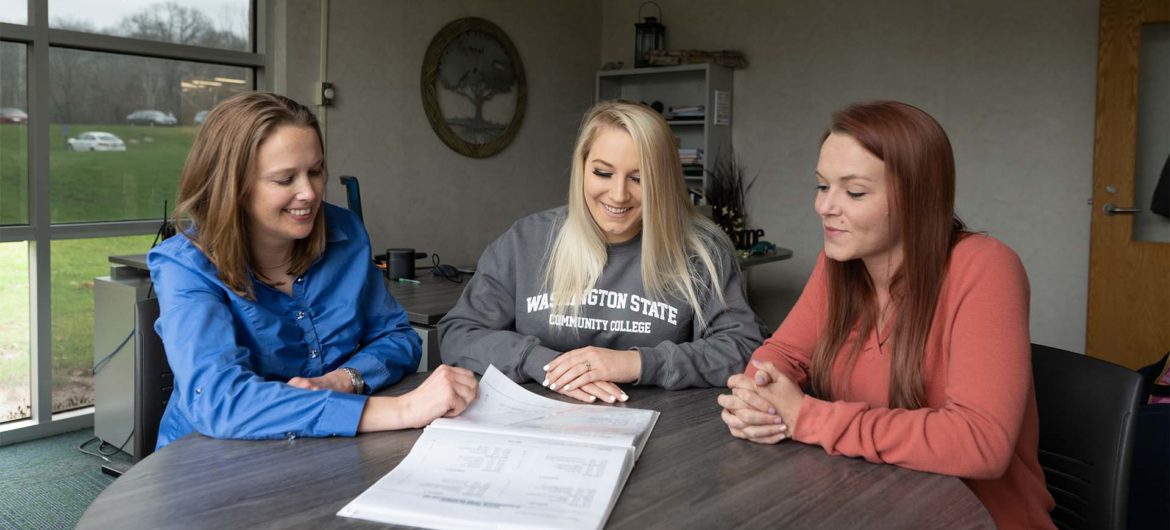MARIETTA—Washington State College of Ohio (WSCO) is part of a national publication hailing its strides in improving student success, called Guided Pathways. As a result of the changes implemented with this initiative, the college has seen improvements in a variety of areas including the number of certificates and degrees awarded, increased course pass rates, and better fall to spring persistence.
The Community College Research Center (CCRC) recently published its article, “Funding Guided Pathways Reforms at Small Colleges: Three Ohio Community Colleges Show How to Do It.” The article, written by authors Davis Jenkins, Serena Klempin, and Hana Lahr, describes how small colleges can fund and sustain Guided Pathways reforms. WSCO, along with Zane State and North Central State colleges were used as case studies. All three institutions saw student success improve significantly as a result of implementing Guided Pathways.
WSCO President Dr. Vicky Wood said the Guided Pathways work implemented at WSCO was inspired by the book Redesigning America’s Community Colleges, which was co-written by Jenkins, one of the authors of the CCRC article. “That book encouraged a movement in community colleges that will forever be a part of the fiber of higher education,” explained Wood. She goes on to credit the authors with “actively directing and impacting the landscape of higher education.”
Wood said the case studies in the book featured large institutions, and many small colleges were inspired by the concept but concerned how it could be applied with limited funding. Undaunted by the idea of scaling the program to fit the needs of WSCO, Wood described how the college divided the change concepts into three phases and implemented its plan over the past four years. “The work we accomplished was a comprehensive redesign of the student experience from a student’s initial contact with the college to degree/certificate completion, and it impacted every facet of the college,” said Wood.
Among the initial successes, Wood shared that overall certificate completion improved more than 11 percent and degree completion increased by more than 9 percent. She added that the college saw a 17 percent increase in new students earning at least 24 college credits in their first year and fall to spring persistence jumped 9 percent.
“These improved numbers are a direct result of our Guided Pathways work. We provide our students with wrap-around support, which means we support them both in and out of the classroom,” Wood explained.
In phase one the college redesigned its Center for Student Success (CSS). This process began by relocating all of its student support services to one location to make it easier for students to access services to help them overcome barriers. A multitude of barriers often cause students to drop out and keep them from earning their degrees and starting their careers. The college also dedicated more resources to student support services that include tutoring, transfer assistance, mentoring, food pantry, and mental health counseling.
In phase two, the college established the Student OneStop where Admissions, College Credit Plus (CCP), financial aid, records, and business office functions were centralized. This was done to personalize support during the initial connection and entry phase of enrollment. The personalized approach was designed to help eliminate the stress of the enrollment process. The college also began offering counseling for financial planning as well as assistance completing the FAFSA (Free Application for Federal Student Aid).
In phase three, the college updated its curriculum delivery models to be more in line with students’ busy lifestyles. A majority of classes were shifted from 16 weeks to an 8-week delivery model. Career pathways were also strengthened by including stackable credentials and certificates where students can attain skills that lead to employment while working towards an associate degree. Additionally, short-term training was added to help incumbent and displaced workers update their skills and earn industry-recognized credentials.
Wood acknowledged the vast scope of changes that have been made by the college and credits the successful implementation of Guided Pathways to her faculty and staff. “Redesigning the student experience was an enormous undertaking that was only possible because our faculty and staff fully embraced the vision. They were instrumental in executing the changes and maintaining our momentum,” praised Wood. She said she believes the publication will serve to support and inspire other small community colleges across the nation to adopt the Guided Pathways initiative.





